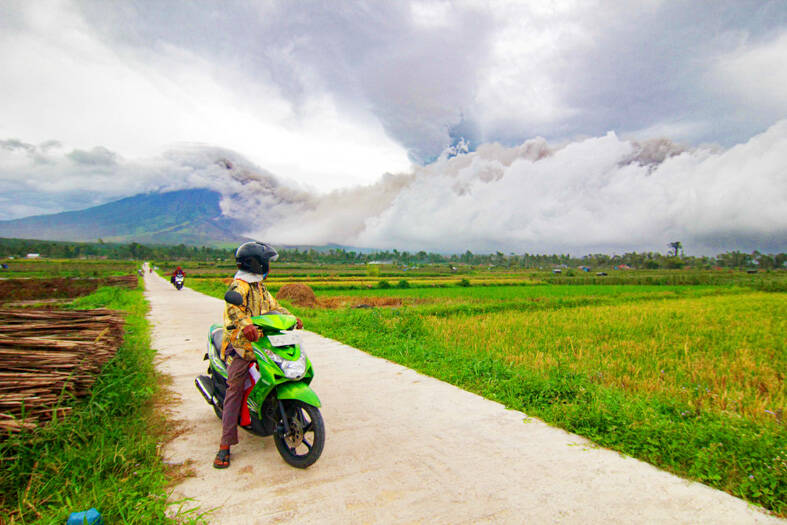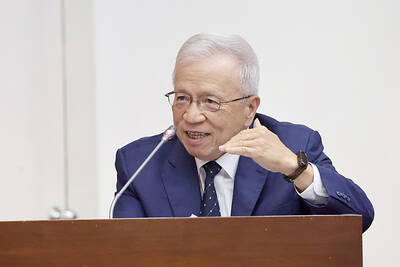Stepping into a “minefield” about how to slow global warming, scientists in developing nations have won new funds to study whether dimming sunshine by mimicking volcanic eruptions can be a sufficiently safe way to temporarily cool a hotter planet.
Research into “solar geoengineering,” perhaps using planes or balloons to spray sun-reflecting sulphur into the stratosphere, has made scant progress despite alarm over rising temperatures and a sluggish global shift from fossil fuels to renewable energy.
Trying to build momentum, the Degrees Initiative, a UK-based non-governmental organization, last week announced US$900,000 in new solar geoengineering funding for researchers in 15 countries, including Chile, India and Nigeria.

Photo: AFP
The money would pay for things such as computer modeling to study how solar geoengineering — also called solar radiation modification (SRM) — might affect everything from monsoons and storms to heat waves and biodiversity.
The new grants follow an initial 2018 round, also worth US$900,000, backing projects in 10 developing nations to understand risks such as worsening droughts in South Africa or possible effects on rice and corn production in the Philippines.
So far, research into a possible planetary sunshade has been dominated by universities in rich nations, such as Harvard University and the University of Oxford.
“The whole point is a redistribution of power on SRM. It is empowering the countries who would be most affected by decisions to use it or reject it,” Degrees Initiative CEO and founder Andy Parker said.
The new funding is a joint project between the Degrees Initiative — funded by Open Philanthropy, backed in part by Facebook Inc cofounder Dustin Moskovitz — and the World Academy of Sciences.
“Given the high stakes, there is a shockingly low level of research around the world,” Parker said, adding that SRM research has attracted somewhere in the “low tens of millions of dollars” globally a year.
Critics say that pursuing SRM as a potential way to deal with climate change could give fossil fuel companies an alibi for inaction, and could disrupt weather patterns, perhaps exacerbating poverty in the most vulnerable nations.
“It is too controversial,” said Chukwumerije Okereke, director of the Centre for Climate Change and Development at Alex Ekwueme Federal University in Nigeria.
“I can list 100 things the world can do [to slow climate change], and geoengineering will not figure among them,” he said.
Okereke, who is also a visiting professor at the London School of Economics, said that a key UN panel of climate scientists did not even mention SRM in a 48-page summary last year to guide policymakers on how to address global warming.
Backers of SRM say the technique draws inspiration from volcanoes. The eruption of Mount Pinatubo in the Philippines in 1991, for instance, cut global temperatures for more than a year as an ashen veil swirled high above the planet.
With the past eight years having been the warmest on record and global temperatures having already risen about 1.2°C above pre-industrial times — approaching the 1.5°C lower limit set in the 2015 Paris Agreement — finding ways to limit heating is crucial, scientists say.
Frank Biermann, a professor of global sustainability governance at Utrecht University, said that SRM is a distraction from the need for the rich to cut emissions.
He said that the average American emits 14.7 tonnes of climate-changing carbon dioxide a year, compared with just 1.8 tonnes per person in India.
If everyone in the world had per-capita emissions equal to those of India — or Africa or most of Latin America — climate change would not be a significant problem, he said.
Swifter emissions cuts by the rich — rather than techno-fixes aimed to buy time for cuts — should be the real focus of efforts to address climate risks, Biermann said.
“The question is who are we buying time for?” he said. “Is it the time for the global population, the poor and the vulnerable? Or is it time bought for the oil industry, the gas industry, the coal industry?”
He said that 390 scientists had signed on to a letter urging a ban on the use of SRM — and he welcomed a decision by Mexico last month to ban experiments after a US start-up, Make Sunsets, launched sulphur-carrying balloons in Mexico without seeking local permits.
Make Sunsets has since shelved plans for new launches.
Researchers involved in the new SRM funding round said that gaining more knowledge about options to deal with climate change is vital.
Andreas Meyer, a researcher at the University of Cape Town who is studying how SRM might affect biodiversity, said that deep cuts in emissions were the best solution for climate change.
However, “further research is needed [for SRM] to fully understand its potential benefits and drawbacks,” he added.
His team is to study how a sun-dimming haze might affect the survival and reproduction of animals, using a database of 30,000 mammals, birds, amphibians, reptiles, fish and marine invertebrates.
The team would also take a look at how the use of SRM might affect mosquito-borne diseases.
Pornampai Narenpitak, an atmospheric climate scientist at the Thai National Science and Technology Development Agency and the leader of one of the research teams, said she welcomed “opportunities for SRM scientists in the Global South to catch up with the research that’s been done in the Global North.”
Her team would study how the use of SRM might affect river flows in the Chao Phraya River basin in Thailand, among other issues.
Pascal Lamy, the former director-general of the WTO who chairs a commission looking at what to do if temperatures overshoot the 1.5°C limit, predicted hard choices ahead as the planet heats up, bringing harsher weather extremes.
“Even if there are obvious risks [in SRM], there are also enormous risks in global warming too,” he said. “It is risk against risk.”
The Climate Overshoot Commission, whose members include former presidents of Mexico and Kiribati, is to issue a report late this year.
When it comes to considering the use of SRM, “I have the impression of walking on a field of landmines,” Lamy said.

JITTERS: Nexperia has a 20 percent market share for chips powering simpler features such as window controls, and changing supply chains could take years European carmakers are looking into ways to scratch components made with parts from China, spooked by deepening geopolitical spats playing out through chipmaker Nexperia BV and Beijing’s export controls on rare earths. To protect operations from trade ructions, several automakers are pushing major suppliers to find permanent alternatives to Chinese semiconductors, people familiar with the matter said. The industry is considering broader changes to its supply chain to adapt to shifting geopolitics, Europe’s main suppliers lobby CLEPA head Matthias Zink said. “We had some indications already — questions like: ‘How can you supply me without this dependency on China?’” Zink, who also

At least US$50 million for the freedom of an Emirati sheikh: That is the king’s ransom paid two weeks ago to militants linked to al-Qaeda who are pushing to topple the Malian government and impose Islamic law. Alongside a crippling fuel blockade, the Group for the Support of Islam and Muslims (JNIM) has made kidnapping wealthy foreigners for a ransom a pillar of its strategy of “economic jihad.” Its goal: Oust the junta, which has struggled to contain Mali’s decade-long insurgency since taking power following back-to-back coups in 2020 and 2021, by scaring away investors and paralyzing the west African country’s economy.

BUST FEARS: While a KMT legislator asked if an AI bubble could affect Taiwan, the DGBAS minister said the sector appears on track to continue growing The local property market has cooled down moderately following a series of credit control measures designed to contain speculation, the central bank said yesterday, while remaining tight-lipped about potential rule relaxations. Lawmakers in a meeting of the legislature’s Finance Committee voiced concerns to central bank officials that the credit control measures have adversely affected the government’s tax income and small and medium-sized property developers, with limited positive effects. Housing prices have been climbing since 2016, even when the central bank imposed its first set of control measures in 2020, Chinese Nationalist Party (KMT) Legislator Lo Ting-wei (羅廷瑋) said. “Since the second half of

Taiwan Semiconductor Manufacturing Co (TSMC, 台積電) received about NT$147 billion (US$4.71 billion) in subsidies from the US, Japanese, German and Chinese governments over the past two years for its global expansion. Financial data compiled by the world’s largest contract chipmaker showed the company secured NT$4.77 billion in subsidies from the governments in the third quarter, bringing the total for the first three quarters of the year to about NT$71.9 billion. Along with the NT$75.16 billion in financial aid TSMC received last year, the chipmaker obtained NT$147 billion in subsidies in almost two years, the data showed. The subsidies received by its subsidiaries —